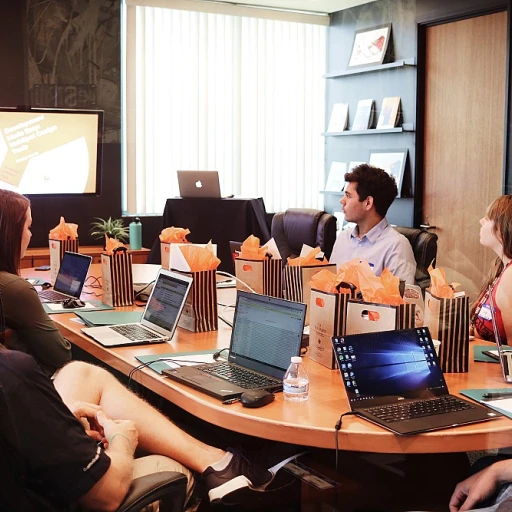
Understanding the Need for Effective Interaction in Remote Work
The Crucial Role of Interaction in Remote Work Settings
In today's fast-paced, digital-driven workplace, efficient communication and collaboration among employees have become more significant than ever. Remote work introduces unique challenges to maintaining a connected company culture. Real-time communication serves as the backbone, ensuring employee engagement and satisfaction remain high.
Effective communication software is vital in bridging geographical gaps and helping build a robust virtual engagement platform. Employee communication tools promote seamless interactions and recognition, which in turn nurture employee experience and sentiment. These tools allow for meaningful feedback, enabling companies to gauge employee satisfaction through pulse surveys and other forms of performance management.
Engaging activities and recognition rewards can further enhance interpersonal bonds, fostering a more cohesive work environment. The timing and effectiveness of these tools are closely tied to the key features of any chosen software platform. Selecting the right communication software can significantly influence employee involvement and feedback culture.
Whether it's through dedicated employee recognition systems or seamless integration with widely-used platforms like Microsoft Teams, the primary goal is to ensure that every member feels valued and heard. Understanding the variety of communication tools available and their potential to create an inclusive and supportive virtual workplace is key to overcoming the challenges inherent in remote work.
Key Features of Effective Employee Interaction Software
Exploring Essential Elements of Interaction Tools
To optimize communication among remote teams, deploying the right software is paramount. Not every platform will meet the unique demands of different companies, but identifying core features ensures clarity and functionality within your remote workforce. Communication tools are at the heart of any interaction platform, offering ways for employees to engage efficiently. The fundamental need is real-time collaboration, making it crucial to look for software that includes video conferencing, instant messaging, and file sharing capabilities. These features help maintain seamless interactions, reflecting the company's culture in its virtual workplace setup. High-performing platforms often integrate tools for employee recognition and feedback to bolster morale and engagement. Recognizing employee achievements and gathering employee sentiment through surveys or pulse surveys can significantly enhance satisfaction. Furthermore, tools equipped with performance management features enable supervisors to provide constructive feedback and track progress. The flexibility of seamless integration with widely used platforms, like Microsoft Teams, is another standout feature. Such integration supports a smoother workflow by minimizing the learning curve and maximizing efficiency. Beyond functionality, pricing remains a decisive factor. Companies must evaluate their budget against the benefits of robust engagement platform tools. An effective solution balances cost with a significant positive impact on communication and employee experience. Effectively choosing the right communication, engagement, and performance management tools ensures a robust remote working environment. For more insights on dynamic communication platforms that nurture organizational culture, you might find it useful to explore enhancing remote work with a social intranet.Top Software Solutions for Remote Team Interaction
Leading Software Solutions to Boost Remote Team Collaboration
Remote work offers flexibility but presents unique challenges in maintaining effective communication and interaction among employees. Various companies have developed software solutions to bridge this gap, fostering better workplace communication and engagement. One standout platform that exemplifies employee engagement software is Microsoft Teams. This robust tool supports real-time communication through video calls, instant messaging, and channels that help streamline team interaction. Its integration with other Microsoft Office applications enhances productivity, making it an essential component of modern company culture. Beyond Microsoft Teams, various platforms specialize in different aspects of internal communication and performance management:- Slack: Known for its intuitive interface and diverse app integrations, Slack encourages seamless employee interaction. Its real-time messaging capabilities, coupled with a user-friendly interface, make it a favorite among remote teams.
- Zoom: Although primarily for video conferencing, Zoom also supports employee recognition and connection through virtual backgrounds and webinars, fostering a positive company culture.
- Asana: This tool helps with task management, enabling teams to stay aligned and maintain engagement through collaborative dashboards and timelines. Asana's features support feedback and recognition without needing constant check-ins.
- Workplace from Meta: Focusing on employee experience and satisfaction, this platform offers an engaging way to handle internal communication. Its emphasis on feedback and employee sentiment through pulse surveys helps companies gauge the impact of their communication strategies.
Challenges in Implementing Interaction Software
Overcoming Barriers in Adoption of Interaction Tools
Implementing employee interaction software in a remote work environment is not without its challenges. These barriers can have significant impacts on the effectiveness of communication tools and, consequently, on overall employee engagement and satisfaction. One of the primary obstacles is the integration of new platforms into existing company systems. Ensuring that the software seamlessly integrates with other tools like Microsoft Teams is crucial for maintaining a cohesive digital workplace. Compatibility issues can disrupt internal communication, leading to a decrease in productivity and employee satisfaction. Moreover, understanding and utilizing the full scope of software features can be challenging for employees. Often, companies overlook the necessity of training, which helps employees maximize the potential of these tools. Continuous education on key features such as real-time communication, feedback mechanisms, and recognition rewards can greatly enhance employee interaction. Another hurdle is the resistance to change within company culture. Employees accustomed to traditional modes of interaction may find it difficult to adapt to digital platforms. To address this, companies need to actively promote a digital-first mindset and provide incentives or recognition to encourage engagement and adaptation. Budget considerations also play a role in the adoption of interaction software. Comparing pricing plans and understanding the cost-benefit is essential. Engagement software not only enhances employee communication but also strengthens employee recognition and workplace culture, justifying the investment. Finally, it is important to measure the impact of these tools to understand their effectiveness in improving remote team dynamics. By utilizing surveys and performance management tools, companies can gather employee feedback and insights into employee experience and sentiment, which inform future strategies to enhance engagement tools. Addressing these challenges head-on allows companies to build a robust framework that supports remote employee engagement and nurtures a positive company culture.Measuring the Impact of Interaction Software on Remote Teams
Evaluating the Benefits of Interaction Software for Remote Teams
Implementing employee interaction software in a remote work environment can significantly influence both employee engagement and satisfaction. By improving communication and offering a platform for feedback, the tools enhance the overall employee experience. However, the ultimate test of their effectiveness is measuring the tangible impact on remote teams.
One primary metric to evaluate is employee engagement. With features like real-time communication and performance management, these platforms aim to keep employees connected and motivated. Regular pulse surveys provide a snapshot of employee sentiment, ensuring management can address concerns promptly, thereby boosting engagement metrics.
For many companies, employee satisfaction is another crucial indicator. When adoption of communication software leads to improved internal communication and employee recognition, satisfaction levels tend to rise. This can be monitored through regular feedback and surveys, gauging how well the interaction tools integrate with company culture.
Additionally, recognition rewards serve as an essential mechanism to acknowledge employees' efforts, contributing to a positive workplace environment. Engagement platforms that incorporate recognition features help maintain high morale across remote teams.
Finally, examining how effectively these software solutions integrate with existing tools—such as Microsoft Teams—can determine their overall influence. Seamless integration enhances efficiency and reduces the time spent navigating different tools, leading to improved employee productivity.












